Organizational Culture: An Evaluation of Hofstede's Dimensions
VerifiedAdded on 2021/01/02
|6
|1338
|329
Essay
AI Summary
This essay delves into the application of Hofstede's cultural dimensions within the context of organizational culture. It begins by defining organizational culture and introducing Hofstede's model, which includes dimensions such as individualism, power distance, uncertainty avoidance, masculinity, and short-term orientation. The essay evaluates the impact of these dimensions, particularly individualism and collectivism, on employee motivation and organizational goal achievement. It then provides a justification for agreeing with the collectivist culture and power distance dimensions, while disagreeing with the uncertainty avoidance element. The author suggests a balanced approach to power distance and highlights the importance of aligning work distribution with employee skills to foster a healthy work environment. The conclusion emphasizes the significance of organizational culture, especially for global businesses, and how the Hofstede model helps in adapting to different cultural environments to enhance productivity and consumer behavior. The essay stresses the need for organizational values that resonate with both internal and external cultural contexts.

Study skills for
higher education
higher education
Paraphrase This Document
Need a fresh take? Get an instant paraphrase of this document with our AI Paraphraser
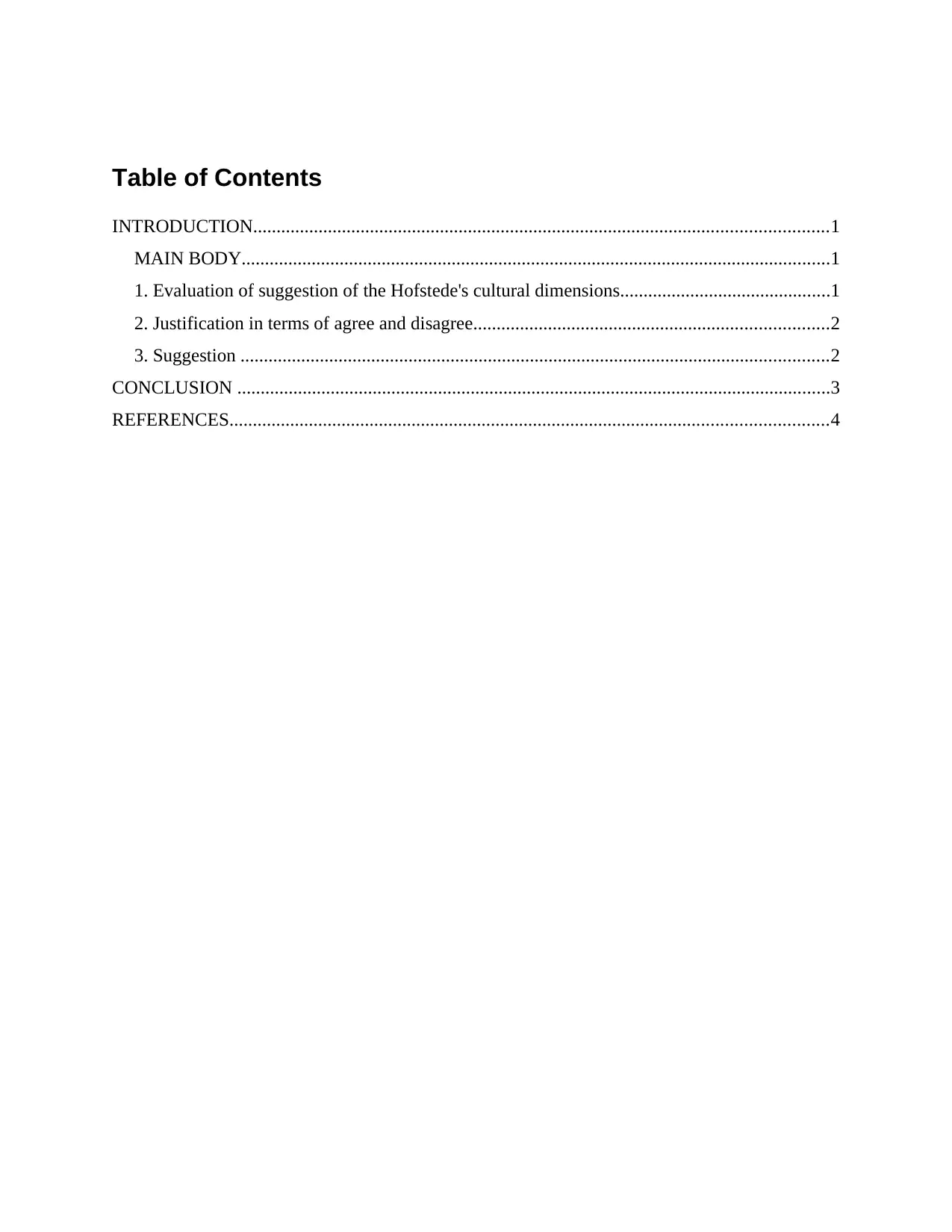
Table of Contents
INTRODUCTION...........................................................................................................................1
MAIN BODY..............................................................................................................................1
1. Evaluation of suggestion of the Hofstede's cultural dimensions.............................................1
2. Justification in terms of agree and disagree............................................................................2
3. Suggestion ..............................................................................................................................2
CONCLUSION ...............................................................................................................................3
REFERENCES................................................................................................................................4
INTRODUCTION...........................................................................................................................1
MAIN BODY..............................................................................................................................1
1. Evaluation of suggestion of the Hofstede's cultural dimensions.............................................1
2. Justification in terms of agree and disagree............................................................................2
3. Suggestion ..............................................................................................................................2
CONCLUSION ...............................................................................................................................3
REFERENCES................................................................................................................................4
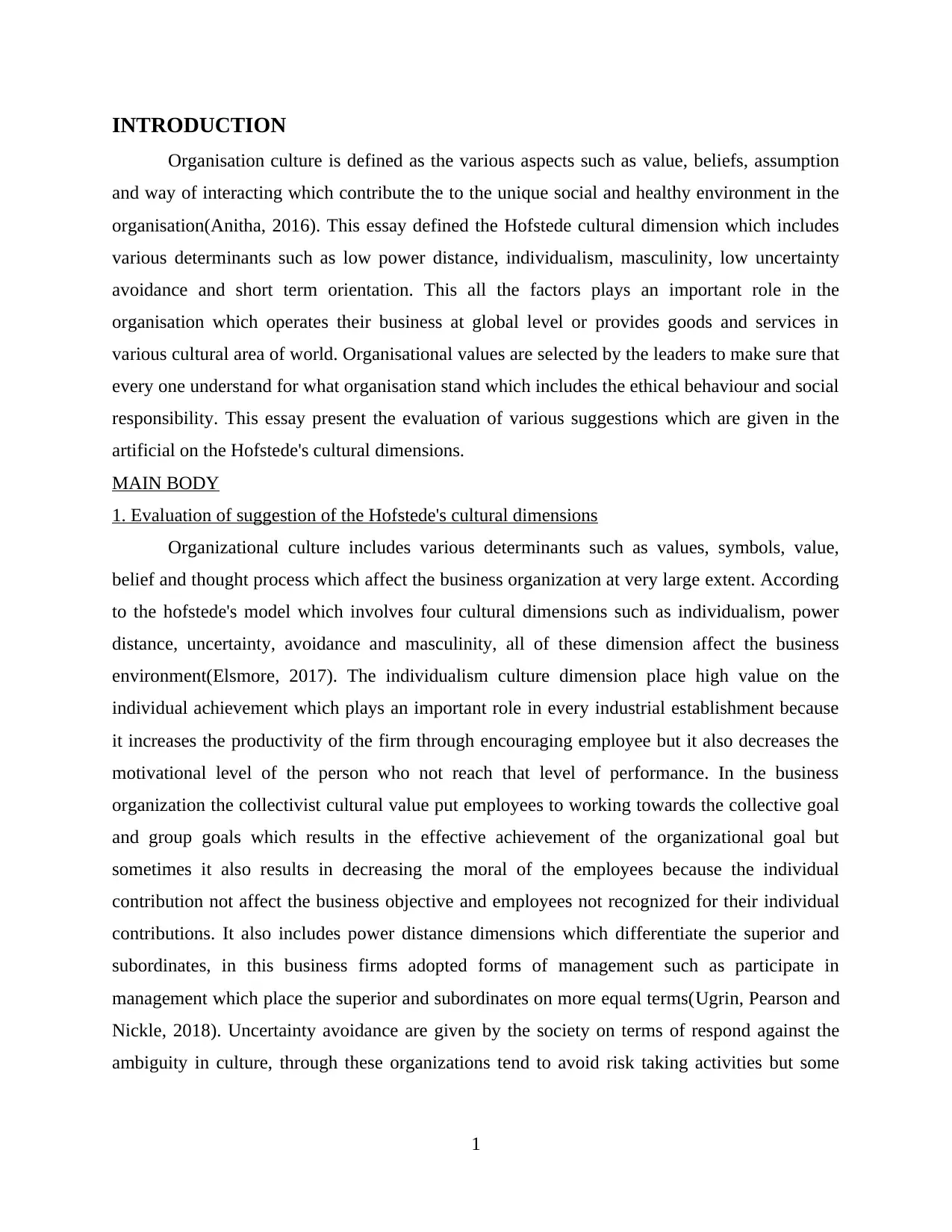
INTRODUCTION
Organisation culture is defined as the various aspects such as value, beliefs, assumption
and way of interacting which contribute the to the unique social and healthy environment in the
organisation(Anitha, 2016). This essay defined the Hofstede cultural dimension which includes
various determinants such as low power distance, individualism, masculinity, low uncertainty
avoidance and short term orientation. This all the factors plays an important role in the
organisation which operates their business at global level or provides goods and services in
various cultural area of world. Organisational values are selected by the leaders to make sure that
every one understand for what organisation stand which includes the ethical behaviour and social
responsibility. This essay present the evaluation of various suggestions which are given in the
artificial on the Hofstede's cultural dimensions.
MAIN BODY
1. Evaluation of suggestion of the Hofstede's cultural dimensions
Organizational culture includes various determinants such as values, symbols, value,
belief and thought process which affect the business organization at very large extent. According
to the hofstede's model which involves four cultural dimensions such as individualism, power
distance, uncertainty, avoidance and masculinity, all of these dimension affect the business
environment(Elsmore, 2017). The individualism culture dimension place high value on the
individual achievement which plays an important role in every industrial establishment because
it increases the productivity of the firm through encouraging employee but it also decreases the
motivational level of the person who not reach that level of performance. In the business
organization the collectivist cultural value put employees to working towards the collective goal
and group goals which results in the effective achievement of the organizational goal but
sometimes it also results in decreasing the moral of the employees because the individual
contribution not affect the business objective and employees not recognized for their individual
contributions. It also includes power distance dimensions which differentiate the superior and
subordinates, in this business firms adopted forms of management such as participate in
management which place the superior and subordinates on more equal terms(Ugrin, Pearson and
Nickle, 2018). Uncertainty avoidance are given by the society on terms of respond against the
ambiguity in culture, through these organizations tend to avoid risk taking activities but some
1
Organisation culture is defined as the various aspects such as value, beliefs, assumption
and way of interacting which contribute the to the unique social and healthy environment in the
organisation(Anitha, 2016). This essay defined the Hofstede cultural dimension which includes
various determinants such as low power distance, individualism, masculinity, low uncertainty
avoidance and short term orientation. This all the factors plays an important role in the
organisation which operates their business at global level or provides goods and services in
various cultural area of world. Organisational values are selected by the leaders to make sure that
every one understand for what organisation stand which includes the ethical behaviour and social
responsibility. This essay present the evaluation of various suggestions which are given in the
artificial on the Hofstede's cultural dimensions.
MAIN BODY
1. Evaluation of suggestion of the Hofstede's cultural dimensions
Organizational culture includes various determinants such as values, symbols, value,
belief and thought process which affect the business organization at very large extent. According
to the hofstede's model which involves four cultural dimensions such as individualism, power
distance, uncertainty, avoidance and masculinity, all of these dimension affect the business
environment(Elsmore, 2017). The individualism culture dimension place high value on the
individual achievement which plays an important role in every industrial establishment because
it increases the productivity of the firm through encouraging employee but it also decreases the
motivational level of the person who not reach that level of performance. In the business
organization the collectivist cultural value put employees to working towards the collective goal
and group goals which results in the effective achievement of the organizational goal but
sometimes it also results in decreasing the moral of the employees because the individual
contribution not affect the business objective and employees not recognized for their individual
contributions. It also includes power distance dimensions which differentiate the superior and
subordinates, in this business firms adopted forms of management such as participate in
management which place the superior and subordinates on more equal terms(Ugrin, Pearson and
Nickle, 2018). Uncertainty avoidance are given by the society on terms of respond against the
ambiguity in culture, through these organizations tend to avoid risk taking activities but some
1
⊘ This is a preview!⊘
Do you want full access?
Subscribe today to unlock all pages.

Trusted by 1+ million students worldwide
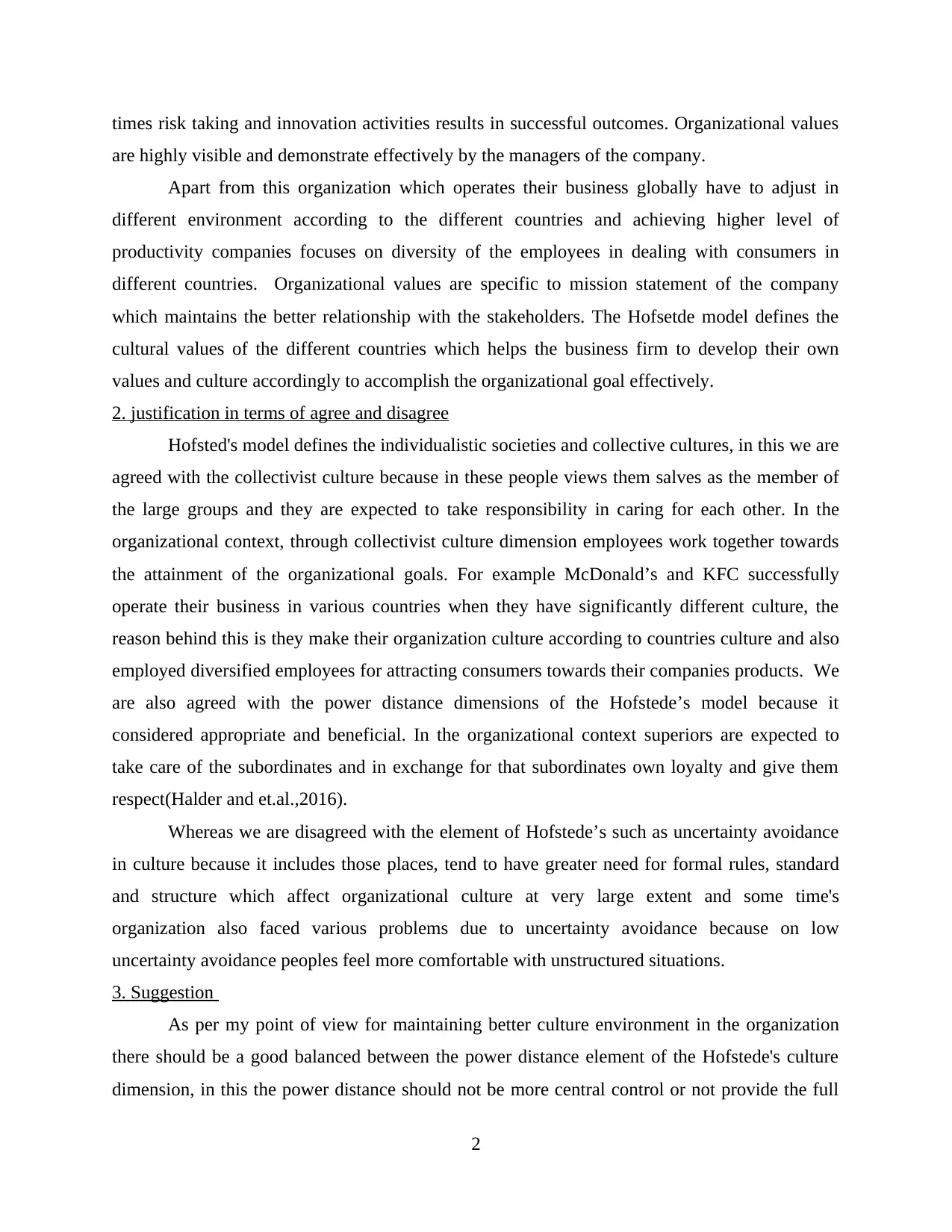
times risk taking and innovation activities results in successful outcomes. Organizational values
are highly visible and demonstrate effectively by the managers of the company.
Apart from this organization which operates their business globally have to adjust in
different environment according to the different countries and achieving higher level of
productivity companies focuses on diversity of the employees in dealing with consumers in
different countries. Organizational values are specific to mission statement of the company
which maintains the better relationship with the stakeholders. The Hofsetde model defines the
cultural values of the different countries which helps the business firm to develop their own
values and culture accordingly to accomplish the organizational goal effectively.
2. justification in terms of agree and disagree
Hofsted's model defines the individualistic societies and collective cultures, in this we are
agreed with the collectivist culture because in these people views them salves as the member of
the large groups and they are expected to take responsibility in caring for each other. In the
organizational context, through collectivist culture dimension employees work together towards
the attainment of the organizational goals. For example McDonald’s and KFC successfully
operate their business in various countries when they have significantly different culture, the
reason behind this is they make their organization culture according to countries culture and also
employed diversified employees for attracting consumers towards their companies products. We
are also agreed with the power distance dimensions of the Hofstede’s model because it
considered appropriate and beneficial. In the organizational context superiors are expected to
take care of the subordinates and in exchange for that subordinates own loyalty and give them
respect(Halder and et.al.,2016).
Whereas we are disagreed with the element of Hofstede’s such as uncertainty avoidance
in culture because it includes those places, tend to have greater need for formal rules, standard
and structure which affect organizational culture at very large extent and some time's
organization also faced various problems due to uncertainty avoidance because on low
uncertainty avoidance peoples feel more comfortable with unstructured situations.
3. Suggestion
As per my point of view for maintaining better culture environment in the organization
there should be a good balanced between the power distance element of the Hofstede's culture
dimension, in this the power distance should not be more central control or not provide the full
2
are highly visible and demonstrate effectively by the managers of the company.
Apart from this organization which operates their business globally have to adjust in
different environment according to the different countries and achieving higher level of
productivity companies focuses on diversity of the employees in dealing with consumers in
different countries. Organizational values are specific to mission statement of the company
which maintains the better relationship with the stakeholders. The Hofsetde model defines the
cultural values of the different countries which helps the business firm to develop their own
values and culture accordingly to accomplish the organizational goal effectively.
2. justification in terms of agree and disagree
Hofsted's model defines the individualistic societies and collective cultures, in this we are
agreed with the collectivist culture because in these people views them salves as the member of
the large groups and they are expected to take responsibility in caring for each other. In the
organizational context, through collectivist culture dimension employees work together towards
the attainment of the organizational goals. For example McDonald’s and KFC successfully
operate their business in various countries when they have significantly different culture, the
reason behind this is they make their organization culture according to countries culture and also
employed diversified employees for attracting consumers towards their companies products. We
are also agreed with the power distance dimensions of the Hofstede’s model because it
considered appropriate and beneficial. In the organizational context superiors are expected to
take care of the subordinates and in exchange for that subordinates own loyalty and give them
respect(Halder and et.al.,2016).
Whereas we are disagreed with the element of Hofstede’s such as uncertainty avoidance
in culture because it includes those places, tend to have greater need for formal rules, standard
and structure which affect organizational culture at very large extent and some time's
organization also faced various problems due to uncertainty avoidance because on low
uncertainty avoidance peoples feel more comfortable with unstructured situations.
3. Suggestion
As per my point of view for maintaining better culture environment in the organization
there should be a good balanced between the power distance element of the Hofstede's culture
dimension, in this the power distance should not be more central control or not provide the full
2
Paraphrase This Document
Need a fresh take? Get an instant paraphrase of this document with our AI Paraphraser
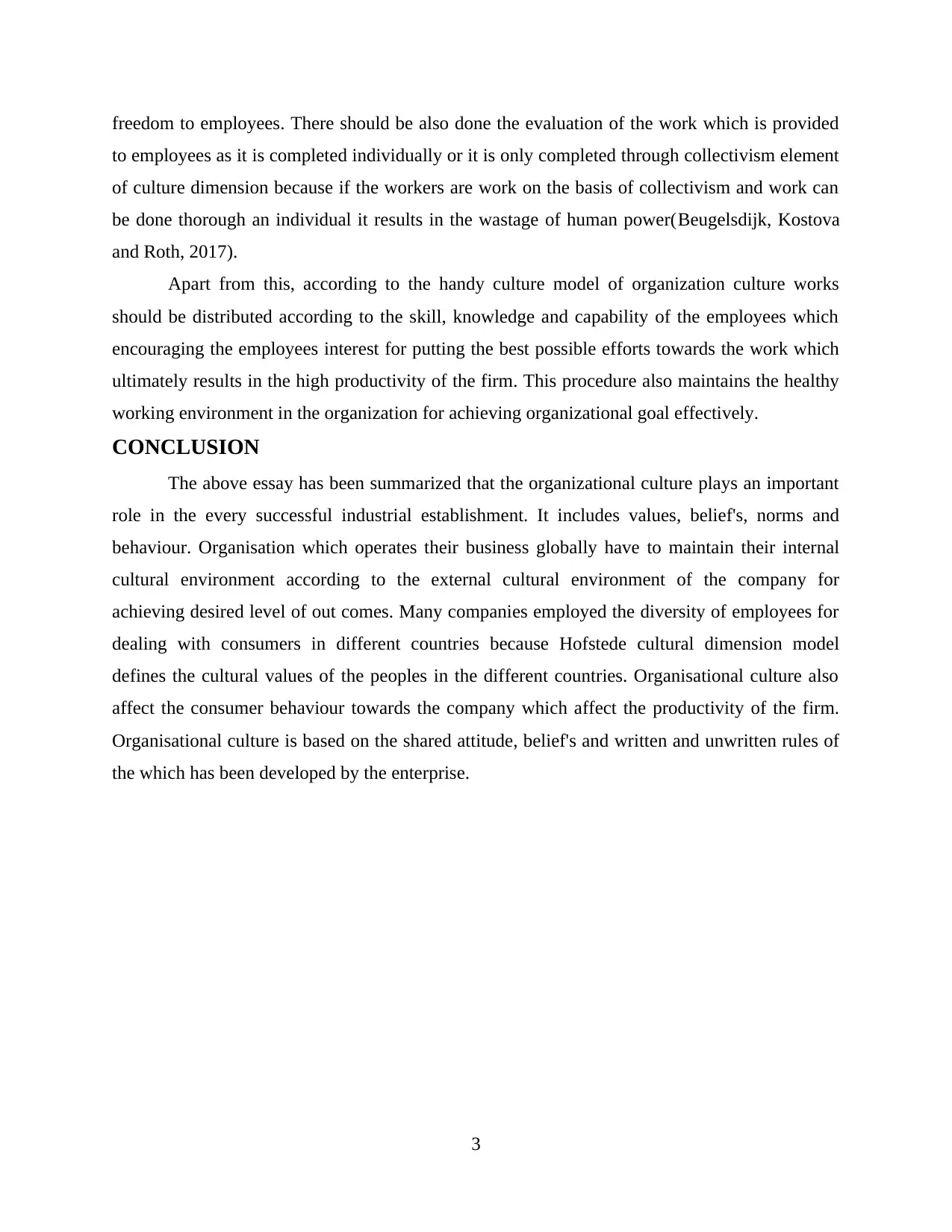
freedom to employees. There should be also done the evaluation of the work which is provided
to employees as it is completed individually or it is only completed through collectivism element
of culture dimension because if the workers are work on the basis of collectivism and work can
be done thorough an individual it results in the wastage of human power(Beugelsdijk, Kostova
and Roth, 2017).
Apart from this, according to the handy culture model of organization culture works
should be distributed according to the skill, knowledge and capability of the employees which
encouraging the employees interest for putting the best possible efforts towards the work which
ultimately results in the high productivity of the firm. This procedure also maintains the healthy
working environment in the organization for achieving organizational goal effectively.
CONCLUSION
The above essay has been summarized that the organizational culture plays an important
role in the every successful industrial establishment. It includes values, belief's, norms and
behaviour. Organisation which operates their business globally have to maintain their internal
cultural environment according to the external cultural environment of the company for
achieving desired level of out comes. Many companies employed the diversity of employees for
dealing with consumers in different countries because Hofstede cultural dimension model
defines the cultural values of the peoples in the different countries. Organisational culture also
affect the consumer behaviour towards the company which affect the productivity of the firm.
Organisational culture is based on the shared attitude, belief's and written and unwritten rules of
the which has been developed by the enterprise.
3
to employees as it is completed individually or it is only completed through collectivism element
of culture dimension because if the workers are work on the basis of collectivism and work can
be done thorough an individual it results in the wastage of human power(Beugelsdijk, Kostova
and Roth, 2017).
Apart from this, according to the handy culture model of organization culture works
should be distributed according to the skill, knowledge and capability of the employees which
encouraging the employees interest for putting the best possible efforts towards the work which
ultimately results in the high productivity of the firm. This procedure also maintains the healthy
working environment in the organization for achieving organizational goal effectively.
CONCLUSION
The above essay has been summarized that the organizational culture plays an important
role in the every successful industrial establishment. It includes values, belief's, norms and
behaviour. Organisation which operates their business globally have to maintain their internal
cultural environment according to the external cultural environment of the company for
achieving desired level of out comes. Many companies employed the diversity of employees for
dealing with consumers in different countries because Hofstede cultural dimension model
defines the cultural values of the peoples in the different countries. Organisational culture also
affect the consumer behaviour towards the company which affect the productivity of the firm.
Organisational culture is based on the shared attitude, belief's and written and unwritten rules of
the which has been developed by the enterprise.
3
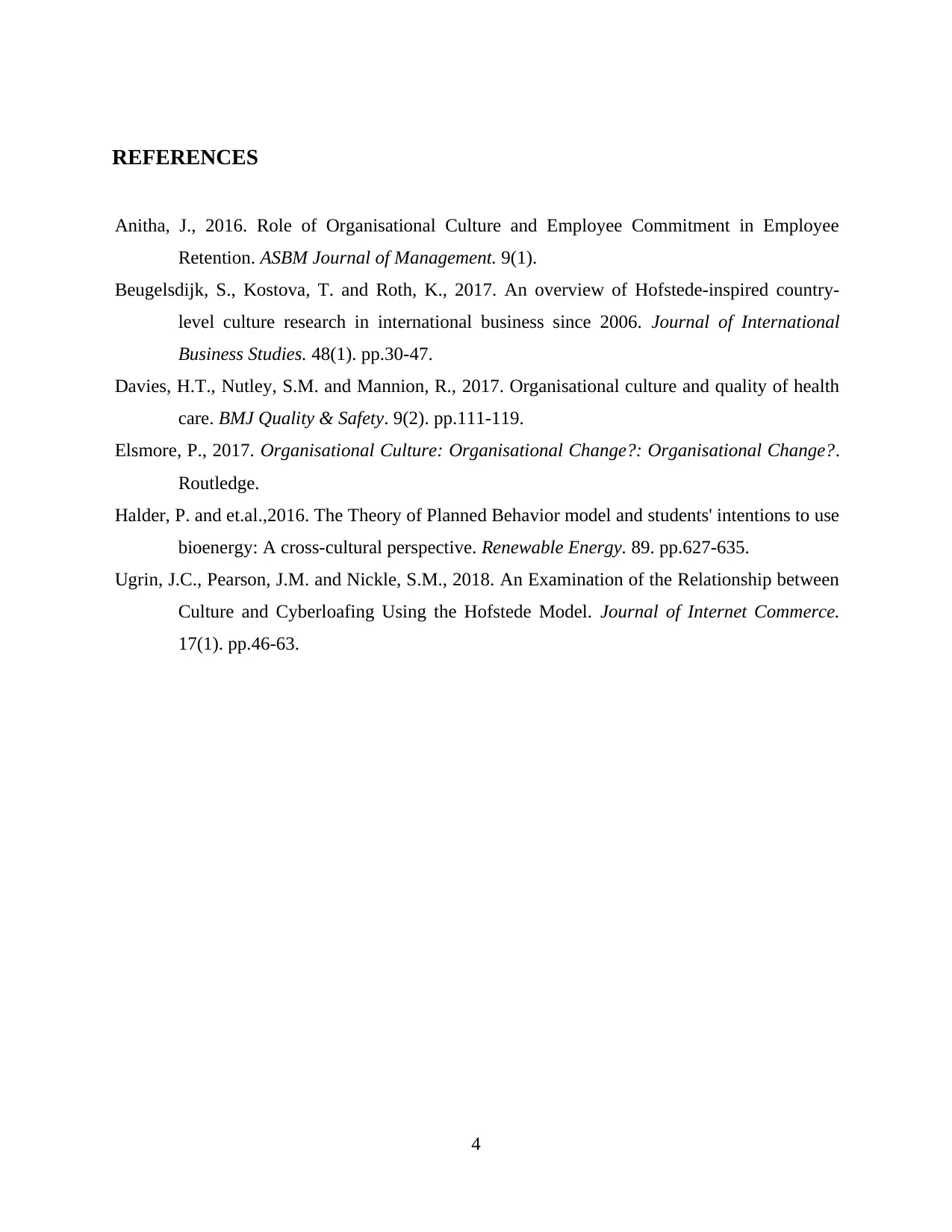
REFERENCES
Anitha, J., 2016. Role of Organisational Culture and Employee Commitment in Employee
Retention. ASBM Journal of Management. 9(1).
Beugelsdijk, S., Kostova, T. and Roth, K., 2017. An overview of Hofstede-inspired country-
level culture research in international business since 2006. Journal of International
Business Studies. 48(1). pp.30-47.
Davies, H.T., Nutley, S.M. and Mannion, R., 2017. Organisational culture and quality of health
care. BMJ Quality & Safety. 9(2). pp.111-119.
Elsmore, P., 2017. Organisational Culture: Organisational Change?: Organisational Change?.
Routledge.
Halder, P. and et.al.,2016. The Theory of Planned Behavior model and students' intentions to use
bioenergy: A cross-cultural perspective. Renewable Energy. 89. pp.627-635.
Ugrin, J.C., Pearson, J.M. and Nickle, S.M., 2018. An Examination of the Relationship between
Culture and Cyberloafing Using the Hofstede Model. Journal of Internet Commerce.
17(1). pp.46-63.
4
Anitha, J., 2016. Role of Organisational Culture and Employee Commitment in Employee
Retention. ASBM Journal of Management. 9(1).
Beugelsdijk, S., Kostova, T. and Roth, K., 2017. An overview of Hofstede-inspired country-
level culture research in international business since 2006. Journal of International
Business Studies. 48(1). pp.30-47.
Davies, H.T., Nutley, S.M. and Mannion, R., 2017. Organisational culture and quality of health
care. BMJ Quality & Safety. 9(2). pp.111-119.
Elsmore, P., 2017. Organisational Culture: Organisational Change?: Organisational Change?.
Routledge.
Halder, P. and et.al.,2016. The Theory of Planned Behavior model and students' intentions to use
bioenergy: A cross-cultural perspective. Renewable Energy. 89. pp.627-635.
Ugrin, J.C., Pearson, J.M. and Nickle, S.M., 2018. An Examination of the Relationship between
Culture and Cyberloafing Using the Hofstede Model. Journal of Internet Commerce.
17(1). pp.46-63.
4
⊘ This is a preview!⊘
Do you want full access?
Subscribe today to unlock all pages.

Trusted by 1+ million students worldwide
1 out of 6
Related Documents
Your All-in-One AI-Powered Toolkit for Academic Success.
+13062052269
info@desklib.com
Available 24*7 on WhatsApp / Email
![[object Object]](/_next/static/media/star-bottom.7253800d.svg)
Unlock your academic potential
Copyright © 2020–2025 A2Z Services. All Rights Reserved. Developed and managed by ZUCOL.




